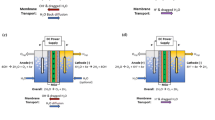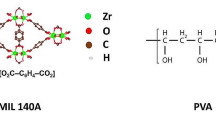Abstract
Nanoporous carbon membranes (NCMs) were fabricated by the blends of resorcinol–formaldehyde (RF) resin and Pluronic F-127 through the processes of assembly, membrane-casting, solidification, and pyrolysis. The effect of the catalyst type (i.e., NaOH and Na2CO3) on the structure and property of precursors and their derived NCMs was investigated. The as-obtained precursors and NCMs were characterized by thermogravimetry, differential scanning calorimetry, x-ray diffraction, Fourier transform infrared spectroscopy, transmission electron microscopy, elemental analysis, nitrogen adsorption, and gas permeation techniques. The results have shown that defect-free NCMs can be easily procured by the NaOH and Na2CO3 catalysts. In contrast, the precursor made from the Na2CO3 catalyst exhibits higher char yield than that from NaOH after pyrolysis. NaOH-based NCMs are beneficial for the separation of H2/N2 and CO2/N2 gas pairs. Na2CO3-based NCMs are more favorable for the separation of O2/N2 with an ideal selectivity of 6.29 and an O2 permeability of 3.27 Barrer.










Similar content being viewed by others
References
A.F. Ismail, D. Rana, T. Matsuura, and H.C. Foley: Carbon-based Membranes for Separation Processes (Springer Science+Business Media, LLC, New York, USA, 2011), p. 302.
Y. Gogotsi, A. Nikitin, H. Ye, W. Zhou, J.E. Fischer, B. Yi, H.C. Foley, and M.W. Barsoum: Nanoporous carbide-derived carbon with tunable pore size. Nat. Mater. 2, 591 (2003).
G. Che, B.B. Lakshmi, E.R. Fisher, and C.R. Martin: Carbon nanotubule membranes for electrochemical energy storage and production. Nature 393, 346 (1998).
M.P. Siegal, D.L. Overmyer, R.J. Kottenstette, D.R. Tallant, and W.G. Yelton: Nanoporous-carbon films for microsensor preconcentrators. Appl. Phys. Lett. 80, 3940 (2002).
J. Jiang, J.B. Klauda, and S.I. Sandler: Monte Carlo simulation of O2 and N2 adsorption in nanoporous carbon (C168 Schwarzite). Langmuir 19, 3512 (2003).
D.R. Paul: Creating new types of carbon-based membranes. Science 335, 413 (2012).
M.G. Buonomenna, W. Yave, and G. Golemme: Some approaches for high performance polymer based membranes for gas separation: Block copolymers, carbon molecular sieves and mixed matrix membranes. RSC Adv. 2, 10745 (2012).
P.S. Tin, Y. Xiao, and T-S. Chung: Polyimide-carbonized membranes for gas separation: Structural, composition, and morphological control of precursors. Sep. Purifi. Rev. 35, 285 (2006).
W.N.W. Salleh, A.F. Ismail, T. Matsuura, and M.S. Abdullah: Precursor selection and process conditions in the preparation of carbon membrane for gas separation: A review. Sep. Purifi. Rev. 40, 261 (2011).
F.K. Katsaros, Th.A. Steriotis, G.E. Romanos, M. Konstantakou, A.K. Stubos, and N.K. Kanellopoulos: Preparation and characterisation of gas selective microporous carbon membranes. Microporous Mesoporous Mater. 99, 181 (2007).
A.B. Fuertes and I. Menendez: Separation of hydrocarbon gas mixtures using phenolic resin-based carbon membranes. Sep. Purif. Technol. 28, 29 (2002).
Y-R. Dong, M. Nakao, N. Nishiyama, Y. Egashira, and K. Ueyama: Gas permeation and pervaporation of water/alcohols through the microporous carbon membranes prepared from resorcinol/formaldehyde/quaternary ammonium compounds. Sep. Purif. Technol. 73, 2 (2010).
W.N.W. Salleh and A.F. Ismail: Effect of stabilization condition on PEI/PVP-based carbon hollow fiber membranes properties. Sep. Sci. Technol. 48, 1030 (2013).
X. Yin, N. Chu, J. Yang, J. Wang, and Z. Li: Thin zeolite T/carbon composite membranes supported on the porous alumina tubes for CO2 separation. Int. J. Greenhouse Gas Control 15, 55 (2013).
B. Zhang, Y. Shi, Y. Wu, T. Wang, and J. Qiu: Towards the preparation of ordered mesoporous carbon/carbon composite membranes for gas separation. Sep. Sci. Technol. 49, 171 (2014).
H.J. Lee, H. Suda, K. Haraya, and S.H. Moon: Gas permeation properties of carbon molecular sieving membranes derived from the polymer blend of polyphenylene oxide (PPO)/polyvinylpyrrolidone (PVP). J. Membr. Sci. 296, 139 (2007).
P.S. Rao, M.Y. Wey, H.H. Tseng, I.A. Kumar, and T.H. Weng: A comparison of carbon/nanotube molecular sieve membranes with polymer blend carbon molecular sieve membranes for the gas permeation application. Microporous Mesoporous Mater. 113, 499 (2008).
Y.K. Kim, H.B. Park, and Y.M. Lee: Gas separation properties of carbon molecular sieve membranes derived from polyimide/polyvinylpyrrolidone blends: Effect of the molecular weight of polyvinylpyrrolidone. J. Membr. Sci. 251, 159 (2005).
X. Zhang, H. Hu, Y. Zhu, and S. Zhu: Carbon molecular sieve membranes derived from phenol formaldehyde novolac resin blended with poly(ethylene glycol). J. Membr. Sci. 289, 86 (2007).
S.S. Hosseini and T.S. Chung: Carbon membranes from blends of PBI and polyimides for N2/CH4 and CO2/CH4 separation and hydrogen purification. J. Membr. Sci. 328, 174 (2009).
C. Liang, K. Hong, G.A. Guiochon, J.W. Mays, and S. Dai: Synthesis of a large-scale highly ordered porous carbon film by self-assembly of block copolymers. Angew. Chem., Int. Ed. 43, 5785 (2004).
L. Song, D. Feng, N.J. Fredin, K.G. Yager, R.L. Jones, Q. Wu, D. Zhao, and B.D. Vogt: Challenges in the fabrication of mesoporous carbon films with ordered cylindrical pores via phenolic oligomer self-assembly with triblock copolymers. ACS Nano 4, 189 (2010).
S. Kataoka, T. Yamamoto, Y. Inagi, A. Endo, M. Nakaiwa, and T. Ohmori: Synthesis of ordered mesoporous carbon thin films at various temperatures in vapor infiltration method. Carbon 46, 1358 (2008).
S. Tanaka, N. Nakatani, A. Doi, and Y. Miyake: Preparation of ordered mesoporous carbon membranes by a soft-templating method. Carbon 49, 3184 (2011).
B. Zhang, Y. Shi, Y. Wu, T. Wang, and J. Qiu: Preparation and characterization of supported ordered nanoporous carbon membranes for gas separation. J. Appl. Polym. Sci. 131, 2136 (2014).
D. Liu, J-H. Lei, L-P. Guo, and K-J. Deng: Simple hydrothermal synthesis of ordered mesoporous carbons from resorcinol and hexamine. Carbon 49, 2113 (2011).
A.M. ElKhatat and S.A. Al-Muhtaseb: Advances in tailoring resorcinol-formaldehyde organic and carbon gels. Adv. Mater. 23, 2887 (2011).
B. Zhang, T. Wang, S. Zhang, J. Qiu, and X. Jian: Preparation and characterization of carbon membranes made from poly(phthalazinone ether sulfone ketone). Carbon 44, 2764 (2006).
A. Benk, M. Talu, and A. Coban: Phenolic resin binder for the production of metallurgical quality briquettes from coke breeze: Part II the effect of the type of the basic catalyst used in the resol production on the tensile strength of the formed coke briquettes. Fuel Process. Technol. 89, 38 (2008).
N. Job, F. Panariello, J. Marien, M. Crine, J. Pirard, and A. Léonard: Synthesis optimization of organic xerogels produced from convective air-drying of resorcinol–formaldehyde gels. J. Non-Cryst. Solids 352, 24 (2006).
C. Lin and J.A. Ritter: Effect of synthesis pH on the structure of carbon xerogels. Carbon 35, 1271 (1997).
H-Z. Wei, C-G. Wang, H-Q. Wang, and Y-J. Bai: Synthesis of high crosslinking density phenolic resin. J. Adv. Mater. 38, 54 (2006).
T. Holopainen, L. Alvila, J. Rainio, and T.T. Pakkanen: Phenol-formaldehyde resol resins studied by 13C-NMR spectroscopy, gel permeation chromatography, and differential scanning calorimetry. J. Appl. Polym. Sci. 66, 1183 (1997).
J-C. Munoz, H. Kua, F. Cardona, and D. Rogers: Effects of catalysts and post-curing conditions in the polymer network of epoxy and phenolic resins: Preliminary results. J. Mater. Process. Technol. 202, 486 (2008).
A.W. Christiansen: Resorcinol–formaldehyde reactions in dilute solution observed by carbon-13 NMR spectroscopy. J. Appl. Polym. Sci. 75, 1760 (2000).
C. Xue, B. Tu, and D. Zhao: Facile fabrication of hierarchically porous carbonaceous monoliths with ordered mesostructure via an organic organic self-assembly. Nano Res. 2, 242 (2009).
A-H. Lu, B. Spliethoff, and F. Schüth: Aqueous synthesis of ordered mesoporous carbon via self-assembly catalyzed by amino acid. Chem. Mater. 20, 5314 (2008).
S. Tanaka, A. Doi, N. Nakatani, Y. Katayama, and Y. Miyake: Synthesis of ordered mesoporous carbon films, powders, and fibers by direct triblock-copolymer-templating method using an ethanol/water system. Carbon 47, 2688 (2009).
W. Zhou, M. Yoshino, H. Kita, and K. Okamoto: Carbon molecular sieve membranes derived from phenolic resin with a pendant sulfonic acid group. Ind. Eng. Chem. Res. 40, 4801 (2001).
R.W. Pekala: Organic aerogels from the polycondensation of resorcinol with formaldehyde. J. Mater. Sci. 24, 3221 (1989).
A. Lu, A. Kiefer, and W. Schmidt: Synthesis of polyacrylonitrile-based ordered mesoporous carbon with tunable pore structures. Chem. Mater. 16, 100 (2004).
K.P. Gierszal, T-W. Kim, R. Ryoo, and M. Jaroniec: Adsorption and structural properties of ordered mesoporous carbons synthesized by using various carbon precursors and ordered siliceous p6mm and ia3̄d mesostructures as templates. J. Phys. Chem. B 109, 23263 (2005).
A.B. Fuertes: Synthesis of ordered nanoporous carbons of tunable mesopore size by templating SBA-15 silica materials. Microporous Mesoporous Mater. 67, 273 (2004).
S. Tanaka, N. Nishiyama, Y. Egashira, and K. Ueyama: Synthesis of ordered mesoporous carbons with channel structure from an organic–organic nanocomposite. Chem. Commun. 2125 (2005).
X. Zhang, H. Hu, Y. Zhu, and S. Zhu: Effect of carbon molecular sieve on phenol formaldehyde novolac resin based carbon membranes. Sep. Purif. Technol. 52, 261 (2006).
J. Carretero, J.M. Benito, A. Guerrero-Ruiz, I. Rodríguez-Ramos, and M.A. Rodríguez: Infiltrated glassy carbon membranes in γ-Al2O3 supports. J. Membr. Sci. 281, 500 (2006).
M. Yoshimune, T. Yamamoto, M. Nakaiwa, and K. Haraya: Preparation of highly mesoporous carbon membranes via a sol–gel process using resorcinol and formaldehyde. Carbon 46, 1031 (2008).
B. Park, B. Ridel, E. Hsu, and J. Shields: Differential scanning calorimetry of phenol–formaldehyde resins cure-accelerated by carbonates. Polymer 40, 1689 (1999).
S. Tanaka, T. Yasuda, Y. Katayama, and Y. Miyake: Pervaporation dehydration performance of microporous carbon membranes prepared from resorcinol/formaldehyde polymer. J. Membr. Sci. 379, 52 (2011).
T. Horikawa, J. Hayashi, and K. Muroyama: Controllability of pore characteristics of resorcinol–formaldehyde carbon aerogel. Carbon 42, 1625 (2004).
I. Menendez and A.B. Fuertes: Aging of carbon membranes under different environments. Carbon 39, 733 (2001).
T. Wang, B. Zhang, J. Qiu, Y. Wu, S. Zhang, and Y. Cao: Effects of sulfone/ketone in poly(phthalazinone ether sulfone ketone) on the gas permeation of their derived carbon membranes. J. Membr. Sci. 330, 319 (2009).
ACKNOWLEDGMENTS
This work was financially supported by the National Natural Science Foundation of China (20906063), the Liaoning Natural Science Foundation of China (20102170), the Program for Liaoning Excellent Talents in University (LJQ2012010), and the State Key Laboratory of Fine Chemicals (KF1107).
Author information
Authors and Affiliations
Corresponding author
Rights and permissions
About this article
Cite this article
Zhang, B., Dang, X., Wu, Y. et al. Structure and gas permeation of nanoporous carbon membranes based on RF resin/F-127 with variable catalysts. Journal of Materials Research 29, 2881–2890 (2014). https://doi.org/10.1557/jmr.2014.327
Received:
Accepted:
Published:
Issue Date:
DOI: https://doi.org/10.1557/jmr.2014.327




